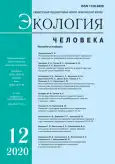Concentrations of heavy metals in animal hair in an urban setting in the Altai Republic
- Authors: Chanchaeva E.A.1, Lapin V.S.1, Kuznetsova Y.V.1, Kurilenko T.K.1, Aizman R.I.2
-
Affiliations:
- Gomo-Altaisk State University
- Novosibirsk State Pedagogical University
- Issue: Vol 27, No 12 (2020)
- Pages: 11-17
- Section: Articles
- URL: https://journals.rcsi.science/1728-0869/article/view/57062
- DOI: https://doi.org/10.33396/1728-0869-2020-12-11-17
- ID: 57062
Cite item
Full Text
Abstract
Keywords
Full Text
##article.viewOnOriginalSite##About the authors
E. A. Chanchaeva
Gomo-Altaisk State University
Email: chan.73@mail.ru
доктор биологических наук, доцент, профессор кафедры физического воспитания и спорта, физиологии и безопасности жизнедеятельности психолого-педагогического факультета Gorno-Altaisk
V. S. Lapin
Gomo-Altaisk State UniversityGorno-Altaisk
Yu. V. Kuznetsova
Gomo-Altaisk State UniversityGorno-Altaisk
T. K. Kurilenko
Gomo-Altaisk State UniversityGorno-Altaisk
R. I. Aizman
Novosibirsk State Pedagogical UniversityNovosibirsk, Russia
References
- Доклад Автономного учреждения Республики Алтай «Алтайский региональный институт экологии» о состоянии и об охране окружающей среды Республики Алтай. URL: http://altai-republic.ru/society/doklad_nature (дата обращения: 26.11.2020)
- Зайцева Н. В., Землянова М. А. Исследование острой токсичности аэрозоля нанодисперсного оксида марганца для прогнозирования опасности здоровью работающих и населения при ингаляционной экспозиции // Анализ риска здоровью. 2018. № 1. С. 89-97. doi: 10.21668/health.risk/2018.1.10
- Качество атмосферного воздуха и здоровье: информационный бюллетень Всемирной организации здравоохранения. 2 мая 2018. URL: http://www.who.int/ru/news-room/fact-sheets/detail/ambient-(outdoor)-air-quality-and-health (дата обращения: 14.04.2020).
- Любченко П. Н., Ревич Б. А., Левченко И. И. Скрининговые методы для выявления групп повышенного риска среди рабочих, контактирующих с токсичными химическими элементами: методические рекомендации (МЗ СССР 28.1 1.1988). М., 1989. 24 с.
- Робертус Ю. В., Рихванов Л. П., Ситникова В. А. Элементный состав лишайника на шифере как биоиндикатор загрязнения атмосферы агломерации г. Горно-Алтайска // Известия Томского политехнического университета. Инжиниринг георесурсов. 2018. № 4 (329). С. 70-78.
- Скальный А. В., Грабеклис А. Р., Скальная М. Г., Тармаева И. Ю., Киричук А. А. Химические элементы в гигиене и медицине окружающей среды. М.: РУДН, 2019. 339 c.
- Селегей Т. С. Метеорологический потенциал самоочищения атмосферы Сибирского экономического района // Труды Западно-Сибирского регионального НИИ Госкомгидромета, 1989. № 86. С. 84 - 89.
- Трофимович-Пиастро Е. М., Айзман Р. И. Гигиена населения. Новосибирск: Плюс Реклама, 2019. 608 с.
- Brewer E., Li Y., Finken B., Quartucy G., Muzio L., Baez Al., Garibay M., Jung H. S PM25 and ultrafine particulate matter emissions from natural gas fired turbine for power generation. Atmospheric Environment. 2016, 4, pp. 141-149. doi: 10.1016/j.atmosenv.2015.11.048
- Chanchaeva E. A., Sukhova M. G., Sidorov S. S. Problems of the health status of children and atmospheric air of Gorno-Altaisk under the conditions of increasing transport load. IOP Conference Series: Earth and Environmental Science. 2019, 395, pp. 1-5. doi: 10.1088/1755-1315/395/1/012004
- Cygan-Szczegielniak D., Stanek M., Stasiak K., Rocelewska A., Janicki B. The Content of Mineral Elements and Heavy Metals in the Hair of Red Deer (Cervus elaphus L.) from Selected Regions of Poland. Folia Biologica (Krakow). 2018, 66. doi: 10.3409/FB62_3.163
- Danilova I. A. Interregional inequality in life expectancy in Russia and its age cause of death components Social aspects of public health. Social Aspects of Population Health. 2017, 57, p. 3. doi: 10.21045/2071-5021-2017-57-5-3
- Du B., Zhou J., Lu B., Zhang C. Environmental and human health risks from cadmium exposure near an active leadzinc mine and a copper smelter, China. Science of The Total Environment. 2020, 720. doi: 10.1016/j.scitotenv.2020.137585
- Esposito M., De Roma A., Maglio P. Bianco R., De Martinis C., Rosato, G. et al. Heavy metals in organs of stray dogs and cats from the city of Naples and its surroundings (Southern Italy). Environmental Science and Pollution Research. 2019, 26, pp. 3473-3478. doi: 10.1007/s11356-018-3838-5
- Lotric Dolinar A., Došenović Bonča P Sambt J. Longevity in Slovenia: Past and potential gains in life expectancy by age and causes of death. Slovenian Journal of Public Health. 2017, 2 (56), pp. 124-130. DOI: 10.1515/ sjph-2017-0016
- Olumayede E. G., Ediagbonya T. F., Ojiodu C., Oguntimehin I. Particle-Size Distribution and Bioaccessibility of Metals-Loaded in Street Dust of Urban Center in Southwest Nigeria. Preprints, 2017. doi: 10.20944/preprints201710.0109.v1
- Park S. H., Lee M. H., Kim S. K. Studies on the concentrations of Cd, Pb, Hg and Cr in dog serum in Korea. Asian-Australasian Journal of Animal Sciences. 2005, 18 (11), pp. 1623-1627. doi: 10.5713/ajas.2005.1623
- Rafati Rahimzadeh M, Rafati Rahimzadeh M, Kazemi S, Moghadamnia A-A. Cadmium toxicity and treatment: An update. Caspian Journal of Internal Medicine. 2017, 8 (3), pp. 135-45. doi: 10.22088/cjim.8.3.135
- Rashed M. N., Soltan M. E. Animal hair as biological indicator for heavy metal pollution in urban and rural areas. Environmental Monitoring and Assessment. 2005, 110 (13), pp. 41-53. doi: 10.1007/S10661-005-6288-8
- Phi T. Ha., Chinh P. M., Cuong D. D. Elemental Concentrations in Roadside Dust Along Two National Highways in Northern Vietnam and the Health-Risk Implication. Archives of Environmental Contamination and Toxicology. 2017, 74, pp. 46-55. doi: 10.1007/s00477-013-0790-2
- Shen X., Chi Y., Xiong K. The effect of heavy metal contamination on humans and animals in the vicinity of a zinc smelting facility. Public Library of Science One. 2019, 14 (10), pp. e0207423. doi: 10.1371/journal.pone.0207423
Supplementary files







